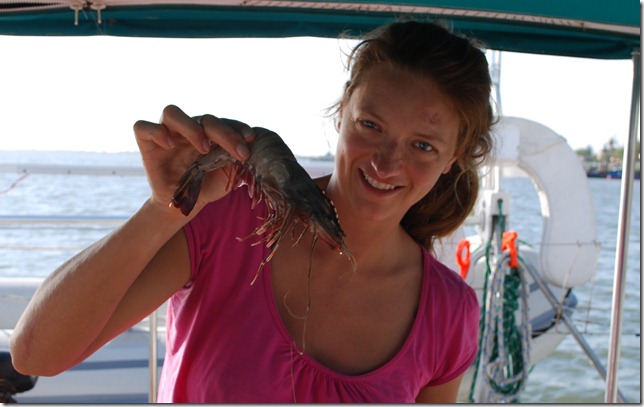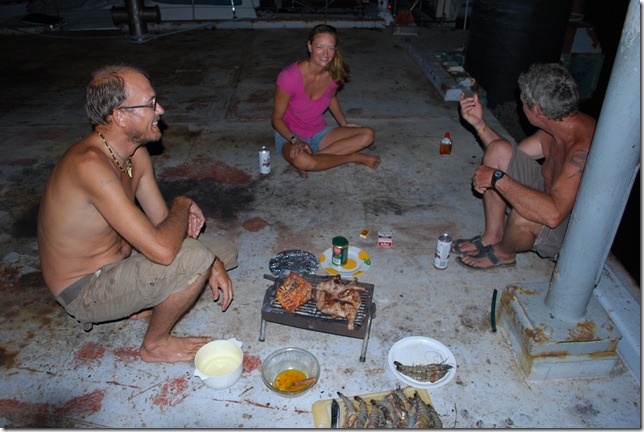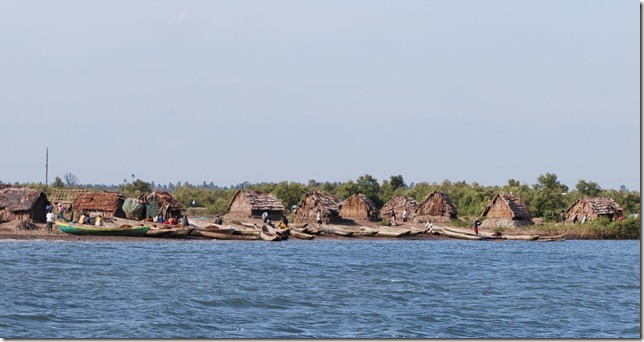Lat: 18 02.000′ S
Lon: 36 57.900′ E
There’s a supermercado in downtown Quelimane. High-wattage signs from the desk of a graphic designer overhang the sidewalk at 20′ intervals — meats, vegetables, fruits. Along both sides of the large corner ground-floor store are larger than large plate glass windows — each one must be more than 15′ wide and 6′ tall. Nearly half of them are still there. Why? They’re too large for one man to remove and carry to sell on the sidewalk (this morning’s offering to passers-by on the sidewalk across from the bakery was a chipped 8’x4′ plate glass window). Or maybe the sealant that holds them to their frames is as modern as the defunct signs and refuses to let them loose without shattering. At any rate, it was at least 10 years ago when the supermarket shut down.
It’s been a while since it’s rained in Quelimane, but the hollow concrete interior of the supermercado adjoining the rust colored dusty street is damp, in places dripping wet with what can only be the leakage from neglected plumbing. There’s a faint odor from the place that suggests it’s been a home for the homeless. It’s two blocks off of the riverfront of a city of more than 200,000 and not more than a 3 minute bicycle taxi ride from the regional governor’s mansion, which, not coincidentally is surrounded by a large open space and the barracks for what is essentially his bodyguard corps.
In the US there’s something called a paneer, which is a sort of small, narrow shelf that you can attach to a bicycle. It has one attachment under the seat and another somewhere near the rear hub that lets you put a small basket or, if you’re ambitious, something as large as an infant behind you as you ride. In Quelimane, this is the local taxi. The paneer is padded and small rods extend from the rear hub for the passenger’s feet. The going price is no more than 30 met (less than a dollar) for anything within the downtown area.
I’m carrying our provisions in my backpack and in plastic bags dangling from each hand as my young and fit “cabbie” exhales forcefully, moving us slowly over the dirt, pavement, and dust-filled potholes that are downtown Quelimane. At one intersection, a truck claims the right of way (might makes right) and the brakes are applied. I instantly understand why there are makeshift but adept bicycle repair shops on the sidewalks and in the markets. We never come to a stop, but I can’t help but laugh at the sound. “Death of a machine” sounds on American TV and movies are nothing compared to this, but a bit of careful balance and it’s behind us. My Spanish makes for very mediocre Portuguese, but combined with backseat driver hand gestures it’s enough to get us to the dock.
Although we’ve only made a couple of brief forays into the safe downtown area, there’s more here than we can fit into a blog. Yesterday we decided that a braai (South African for BBQ) was in order. After taking us to one of the local markets where we stocked up on veggies, found me a new pair of slops (SA for flip-flops), and picked up a chic “Obama” webbing-style belt for Lauren, Garth led us to “little Maputo” (don’t come here after dark). It’s the first time I’ve seen a house made of small tree branches and mud equipped with a digital electricity meter. Never-paid-for oil from Garth’s family’s boat was still evident in the home-made mortar used in the “house” that we visited for “prawns”. The shrimp at the top of the box were about 12″ long. Roughly 20 plus of these shrimp were frozen and stacked in a box that we paid a whopping $15 for (per the madam of the house, the recent lack of rain has exerted atypical upward pressure upon estuary prawn prices).
 Quelimane, where all the shrimp are above average
Quelimane, where all the shrimp are above average
Back at the dock Gavin and Garth treated us to an SA-style shrimp and chicken braai that according to Lauren will go down as one of the best meals she’s ever experienced (being a vegetarian does have its drawbacks).
 High-brow braai on the dock at Quelimane with Garth & Gavin
High-brow braai on the dock at Quelimane with Garth & Gavin
After filling our water tanks and shoving off with the outgoing tide, we’re now anchored at the mouth of the “River of Two Good Signs” waiting to sail south in the morning. The blinding almost full moon above us and the strong warm wind make the nearby beach we can just make out seem like something from a tropical paradise. A steady white light on the eastern horizon keeps getting brighter and is most likely either one of the 2-3 Maputan-owned fishing vessels that occasionally docks at the modern-but-deteriorating Japanese-donated fishing dock we just left or one of the no more than 2-3 ships per month that visits the port of Quelimane, which is being dredged daily by a dredging vessel that was most likely donated or subsidized by the West and then “privatized” at a good ‘ole boy rate to a government official’s relative whose company now has a lucrative dredging contract for the bustling port of Quelimane.
 Typical riverfront fishing village with thatched huts and dugout canoes
Typical riverfront fishing village with thatched huts and dugout canoes
We’ve seen street vendors that are more respectful than their Asian (Bali) counterparts, surprisingly honest officials, a conniving and devilishly endearing boat boy, kid’s yelling F-you to us from river-front fields next to thatched-rood huts, unabashedly “racist” whitey’s, international aid workers staring and nodding with the “you’re from my world” look, and tons of people proudly wearing American T-shirts. As Gavin aptly told us, “You’re having an experience.”

